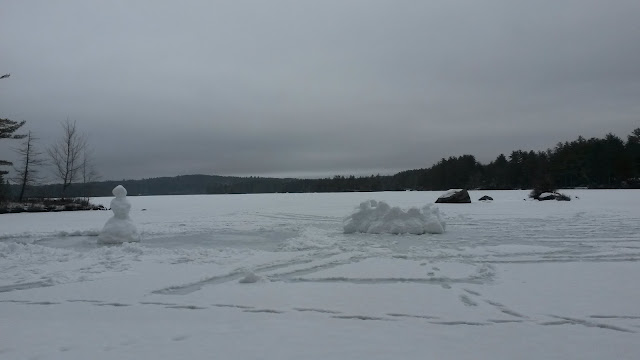More snow this week - it's beautiful around the lake now, and definitely winter!
 |
| Got Snow? |
After seeing the bobcat return last week I decided to go out and follow its tracks to see what I could learn about their life in the wild. The first thing I discovered is that they don't follow the direct, straight line path that a fox does. He (I'll call it a "he" for reasons to be explained in a minute) tended to wander on a more twisty-turny path than the fox. It walked to and around lots of trees, under low hanging branches, in general, making my life difficult! At one point the trail ended at a small hemlock tree with no indication of where he went next.
 |
| A dead-end trail |
I searched for exiting tracks, even checking neighboring trees to see if he jumped over to another tree, but nothing. Finally I realized I hadn't noticed that the trail I was following was actually a two-way trail. He had turned around at the hemlock and walked back using the exact same footprints, the only clue being foot drag marks on both sides of each print. So I went back to the tree to see why he went there, and found the answer. Look at the picture - he had a nice blind to hide behind with a peep hole out to a clearing where squirrels travel frequently. He probably laid there for a while, looking to see if this would be his lucky spot that day.
Retracing the trail I found the fork where he left his double track and I picked one of them to follow. Perhaps a third of mile along I came across another spot where he had set up shop to work on lunch.
 |
| Hiding atop a small bluff (that's my snowshoe print on the far left) |
Here there was a round bed melted in the snow right at the top of a ledge, where once again, he had a well-hidden spot with a wide view. But again, no indication he found anything to go after. Continuing along I came across the sign that led me to believe this was a male bobcat.
 |
| Marking his territory |
Although hard to see, it's the tell tale sign of a male marking territory: a sprinkle of urine in the snow on a hemlock branch.
Becoming more acquainted with his habits, when his trail approached this turn-around I knew what I was looking at.
 |
| A blind for watching wildlife that a duck-hunter would be proud of |
All told I followed his trail for about a mile, learning where he travels and how he hunts for food. The literature on bobcats state that rather than stalking prey they tend to hang out in hiding spots, waiting for their food to walk by and then pounce, and my observations are consistent with this. But not surprisingly, I have evidence they use whatever method suits the moment.
The very next day, the cat came back. (Hmmm, maybe there's a song in there....) He was moving slowly this time, creeping carefully along towards the bird feeders where a couple of red squirrels were feeding on the ground. He crept slowly and carefully.
He slunk to the base of tree where a squirrel had disappeared.
Then pounced!
He dug deep into the snow for over a minute, but those squirrels have great tunnels, and it was long gone out to another entrance - we saw it scampering up a tree right above the cat. The bobcat did pop his head up a couple times to look around.
I don't know if he didn't see the squirrel - hard to imagine - or whether he knew he couldn't catch a red squirrel by the time it was up in the dense branches of pine and hemlock trees. So he sat in the hole he had dug, waiting to see if anyone else dared to come by.
 |
| Here he is, in yet another hiding spot |
I can picture him sitting like this in each of the spots I found on my earlier hike.
I was a little surprised to see birds still flying to the feeders with a cat in the yard - you can see one approaching the feeder in an earlier picture - but neither bird nor cat seemed to pay any attention to each other.
After a few minutes he went on his way along the lake following the shoreline. Another effort that went unrewarded. It's a good thing they have nothing to do all day but hunt.
I enjoyed my time learning about these secretive creatures first hand. Books are great, but there's nothing like experiencing animals in their natural habitat. It's just another reminder of the importance of
protecting special places.











































